Article Archive
Infrared Windows 101 – The Basics You Need to Know
 Mary Molle, Vice President
Mary Molle, Vice President
Abstract
Most people involved with electrical system maintenance have heard of infrared windows, but many do not have a working knowledge of them. Until there is a solid understanding of the “What, Where, and How” of infrared windows, this valuable asset is under used by facilities. This paper will explain what IR windows are and how they work, outline the different options currently available, and provide direction for a facility looking to start or enhance an existing Infrared Window Program.
Background
Thirty years ago, performing an infrared electrical system survey was a “new” concept that required explaining and selling the concept and benefits to plant management before the first thermogram could be taken. Through education, documented payback and industry recognition, infrared electrical system surveys are now accepted, and demanded, parts of a PPM program. With the acceptance of this technology, a new set of challenges must be addressed – data management, efficiency and safety.
One of the most basic tenants of infrared thermography is: infrared imagers do not see through metal. Because thermal imagers cannot see through solid materials, switchgear panel covers must be opened or removed to afford line-of-sight access to subject components. In most cases, panel cover removal and replacement is the most labor-intensive aspect of an infrared inspection, causing safety, efficiency and manpower difficulties. In some cases, these concerns threatened the continuation of infrared electrical system survey programs.
The solution to this problem has been the development of a method to perform the infrared electrical system survey without removing or opening the component covers and keeping the integrity of the data collected. Installed at strategic locations on switchgear enclosures, IR windows permit infrared inspections to be conducted without having to open or remove panel covers, thereby saving time and money and improving safety.
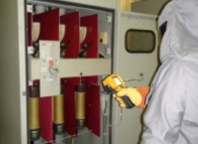 |
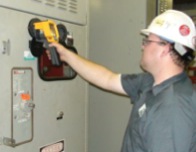 |
What is an IR Window?
An infrared window is an engineered optic designed to permit infrared inspections of electrical components located within switchgear enclosures. Infrared windows consist of a metal or plastic frame that supports an infrared transmissive optic. Infrared windows usually have a protective cover for the optic when they are not in use. Depending upon the window, optics may be made from crystal or polymer material.
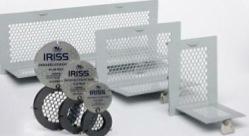 |
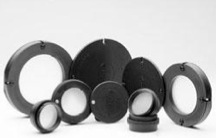 |
Are Ports and Grills Different from IR Windows?
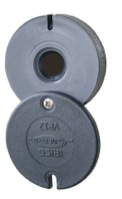 Although many people refer to ports and grills as ‘windows’, there are key differences between them. An infrared port consists of a metal or plastic frame that has a single, small diameter opening (< 0.5 inches) to permit viewing of components located within switchgear enclosures. Due to their small diameter opening, ports usually require the use of special wide angle or ‘fisheye’ lenses with a thermal imager designed to accept such lenses.
Although many people refer to ports and grills as ‘windows’, there are key differences between them. An infrared port consists of a metal or plastic frame that has a single, small diameter opening (< 0.5 inches) to permit viewing of components located within switchgear enclosures. Due to their small diameter opening, ports usually require the use of special wide angle or ‘fisheye’ lenses with a thermal imager designed to accept such lenses.
Grills are similar to ports; however, they are usually larger in overall diameter and contain a metal plate containing multiple small diameter openings. The thermal image taken with a grill in place will show the metal plate with the electrical component data visible only through the openings.
How Do IR Windows Work?
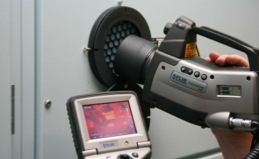 An IR window is a data collection point installed in the metal cover of the electrical switchgear. The window consists of a backing ring, the lens, and the front ring with a cover to secure the opening. This makeup results in the lens being in a secure housing, forming a barrier between the interior and exterior environments. When selecting the IR window to install, several factors should be considered, including the following:
An IR window is a data collection point installed in the metal cover of the electrical switchgear. The window consists of a backing ring, the lens, and the front ring with a cover to secure the opening. This makeup results in the lens being in a secure housing, forming a barrier between the interior and exterior environments. When selecting the IR window to install, several factors should be considered, including the following:
-
Available field of view
-
Camera lens compatibility
-
Intended environment Components to be inspected
-
Safety considerations
What Types of Electrical Equipment should have IR Windows?
Ideally, all electrical enclosures should have an IR window, provided that the installer of the IR window allows adequate access for thermal imaging. Opening lighting panels for an infrared inspection takes time, manpower and has a safety risk; however, facility budgets generally do not allocate funds to install windows everywhere. Deciding which equipment will have IR windows installed should be based on several factors, including the following:
-
Frequency of inspections on a given piece of equipment
-
Complexity of opening the panels
-
Arc flash precautions
-
Facility safety requirements
Equipment where IR windows are usually considered include:
-
Motor Control Centers
-
Dry-type Transformers
-
Distribution Panels
-
High and Medium Voltage Switchgear Cabinets
-
High and Medium Circuit Breakers
-
Control Cabinets
Where Should IR Windows be Installed?
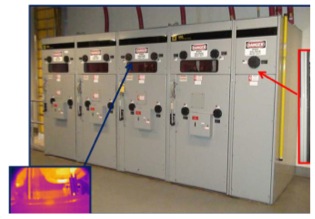 Proper placement of infrared windows is a critical consideration that goes beyond visual aesthetics of the final installation. To maximize effectiveness, window placement must take into account several factors including location of components within enclosures, internal obstacles such as arc barriers, and required field of view. Working with a professional installer or thermographer who is familiar with the subject electrical devices will often yield the best results for window placement.
Proper placement of infrared windows is a critical consideration that goes beyond visual aesthetics of the final installation. To maximize effectiveness, window placement must take into account several factors including location of components within enclosures, internal obstacles such as arc barriers, and required field of view. Working with a professional installer or thermographer who is familiar with the subject electrical devices will often yield the best results for window placement.

What is the Difference Between Crystal and Polymer lens?
Originally, all IR Windows consisted of a crystal lens. Today, Germanium, Zinc Selenide, Calcium Fluoride, and Sapphire are common materials used to make lens.
|
Crystal Advantages |
Crystal Limitations |
|
|
Ideal for high ambient temperatures |
Limited to 4″ diameter |
In the past several years, polymer lens have gained popularity. These may be opaque or clear and with or without reinforcement.
|
Polymer Advantages |
Polymer Limitations |
|
|
Ideal for industrial environments |
Not suitable for high temperature environments (over 200°C) |
How to Begin an IR Window Program?
To begin an IR Window Program, establish a list of all equipment that should have IR windows. Prioritize each piece of equipment that ideally should have a window installed. Plan the installation of the windows starting with the highest priority, taking into account electrical equipment availability (shutdown schedules), frequency of inspections and hazards.
When purchasing IR windows, consider bulk purchases. In addition to possible discounts, having more windows available will prevent any delays during installation and possibly allow additional windows to be installed if an opportunity arises.
Who Should Install the IR Windows?
Because infrared window installations require modifying electrical enclosures, qualified electricians who understand proper window placement are often the best choice. When uncertain of correct window placement, electricians may opt to work with an experienced thermographer to help with window sighting.
Be sure all targets are identified. In addition to fuses and breakers, include cable and bus connections and any mechanically fastened connection. Placement of IR ID labels should be considered during installation to ensure repeatable data collection during IR inspections.

What are the Benefits of an IR Window Program?
No one will deny the safety hazards involved when working with energized electrical equipment. The need to perform more comprehensive infrared inspections, while reducing safety risks, is facilitating the installation of infrared windows.
Cost Savings/ Increased Efficiency: Using infrared windows has been shown in time studies to eliminate over 90% of the time involved with inspections. Inspections will no longer require multiple trained staff to open and close the panels. And after all… time is money!
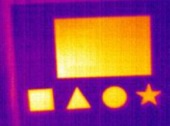 Data Management: IR windows provide a systematic approach to data collection during inspections – same target, same location, same angle, and same distance. Consistency in the data collection process leads to more trendable data in any PdM process.
Data Management: IR windows provide a systematic approach to data collection during inspections – same target, same location, same angle, and same distance. Consistency in the data collection process leads to more trendable data in any PdM process.
Risk Management: The Hierarchy of Control requires engineers and managers to eliminate risk where possible (as opposed to relying on engineering controls or PPE to protect personnel after the accident happens). Use of IR inspection windows eliminates the high risk behaviors involved with open panel inspections and replaces them with a non-intrusive work process.
Safety: The possibility of performing an infrared survey of energized electrical equipment without removal of the panels reduces the risk of electrocution or an arc flash incident.
Standards Complaint: The equipment is maintained in an enclosed and guarded condition without creating a potential electrical hazard during inspection. Therefore, elevated levels of PPE are not required when using an IR window.
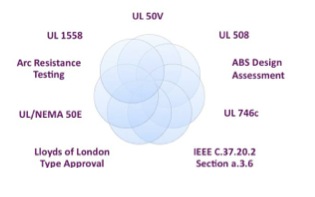
Calculating Cost Savings
Ideally, increased safety and reduced risk of injury should be enough reason to install IR windows. However, some facilities will be required to show the Cost Savings. Below is an abbreviated formula to demonstrate savings.
|
Electricians required to open/close |
X |
Number of days to = perform the Survey |
= |
Number of Electrician Man Days |
|
Electrician Man Days |
X |
Cost per electrician per day |
= |
Total Cost of Electricians |
|
Number of days to perform Survey |
X |
Cost of Thermographer per day |
= |
Thermographer Cost |
Cost to perform an IR Electrical Survey without IR Windows:
Total Cost of Electricians + Thermographer Cost + PPE Equipment Cost = $$$$$$$$$
Cost to perform an IR Electrical Survey with IR Windows:
Total Cost of Electricians = $0
PPE Equipment Cost = $0
Thermographer Cost = reduced by up to 90%
This is a simplified version of the calculation that clearly demonstrates the potential savings of installing IR Windows. Of course, the purchase and installation cost must be taken into account but these are one-time costs that could be capitalized. If you are starting or continuing an Infrared Window Program, contact your IR window manufacturer or representative. Their resources and expertise, combined with your knowledge of your facility, will ensure a successful program!
Advertisement


